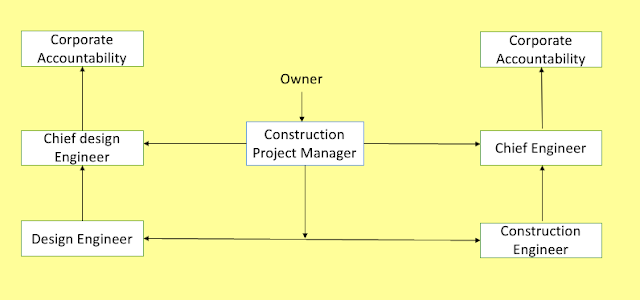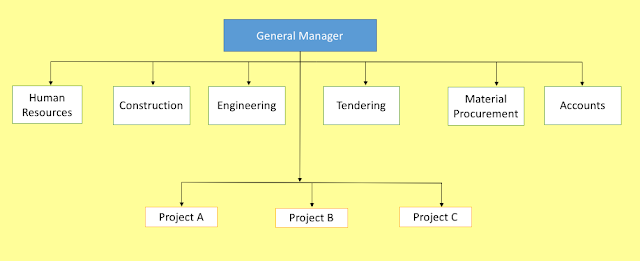ORGANIZATION FOR PROJECT MANAGEMENT
In a construction company the organization at project level and at corporate level is not the same. The primary function of a construction company is to execute construction projects. This function is performed by companies following different organizational structures at project level.
Depending on the extent to which the authority is delegated to a project manager and the mode in which the power is delegated, the project management structure can be divided in three categories :
(a) Functional organization (classical)
(b) Matrix organization
(c) Pure project or product organization
(a) Functional organization (Classical Organization) :
The basis of a functional organisation is specialisation. In such an organisation work is carried out on a functional basis and each function is carried out by a specialist.
According to F.W. Taylor, the ideal situation in such an organisation would be when each person performs specified function only. This removes the staff personnel from his assisting capacity and gives him authority and responsibility for supervision and administration.
The idea behind this type of organisation is to divide the work in such a manner that each person has to perform a minimum number of functions and is fully responsible for those aspects of work.
All similar and related work is grouped together under one person. The functional organisation can be useful when the owner himself acts as the manager of the project with a minimum staff depending upon others for functional expertise.
For example, the work of data collection and preparation of maps for various irrigation schemes of a state is done by Irrigation Investigation Circle. Similarly design of irrigation schemes and large buildings is done by Central Design Organisation.
Advantages :
- In this type of organisation expert advise is available through specialists.
- The entire work is divided on the basis of functional specialisation. Thus efficiency will increase.
- Quality of work is enhanced due to specialisation.
- Manual work is separated from mental work.
- The efficiency of the work will increase as each person has to perform limited number of functions.
Disadvantages :
- There is no clear cut line of authority.
- Co-ordination is difficult.
- It is difficult to fix responsibility.
- Overhead costs are increased due to a number of specialists.
- Each sub-ordinate is accountable to a number of bosses. It may weakens the discipline in the organisation
- The system is too complicated. It is unsuitable for lower level departments of the organisation.
(b) Matrix Organization :
Figure shows Matrix Organisation for construction company
In this type of organisation strong and good points of line and staff organisation are retained.
It divides the power into functional and project responsibilities.
In this type of organisation the conflicts between the line personnel and staff personnel are minimised, by opening up lines of communication at all levels through the assignment of dual reporting responsibility to the subordinate managers.
Functional repsonsibilites such as design, quality control have been entrusted to the functional personnel or staff and project responsibilities such as cost, schedules they have been given to the chief project manager.
Advantages :
- This type of organisation removes some of the weaknesses of line and staff organisation.
- This pattern is best suited in case the project authority and functional authority is well defined and clearly divided.
- The structure facilitates quick response to changes, conflicts and project needs.
- There is flexibility of establishing independent policies and procedure for each project, provided that they do not contradict company policies and procedures.
- There is possibility of achieving better balance between time, cost and performance.
Disadvantges :
- Overall management and administrative cost will be higher.
- It is difficult to precisely define the accountability of the functional and project managers.
- Initially more effort and time is needed to define policies, procedure, responsibilities and authority relationships.
- The balance of power between functional and project authority must be carefully monitored.
- Functional managers may be biased according to their own set of priorities. Reaction times in a fast changing project are not as fast as in the pure project authority structure.
(c) Pure Project or Product Organisation :
Pure project or product organizations can be formed to support a steady flow of ongoing projects. In this type of organization employees are grouped by project.
The majority of the organizations resources is directed towards successful completion of projects.
The project managers enjoy a great deal of independence and authority.
In such structures, the different organizational units called departments either report directly to the project manager or provide supporting roles to the projects.
Figure shows a typical pure project organization.
Advantages :
- The project manager has complete control over the project.
- The lines of communication are strong and open.
- The system is highly flexible and capable of rapid reaction times.
- The project is the only real concern of the project employees. It brings together all
- the administrative, technical and support personnel needed to bring a project from the early stages of development to operational use.
- The appraisal of employees is based upon the performance of the project.
Disadvantages :
- There could be a duplication of efforts.
- The administrative duties of a project manager may be demanding and the job could be quite stressful.
- It is difficult to find a project manager having both general management expertise and diverse functional expertise.
- Due to the fear of impediments in career growth, some employees may not prefer to leave their departments.


